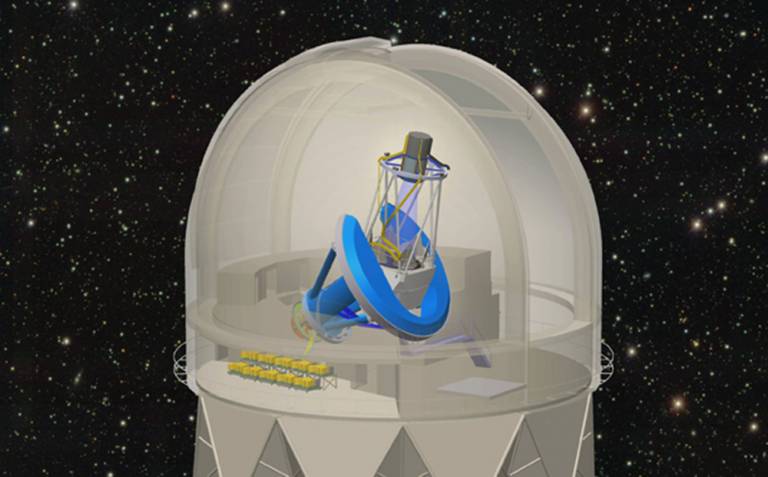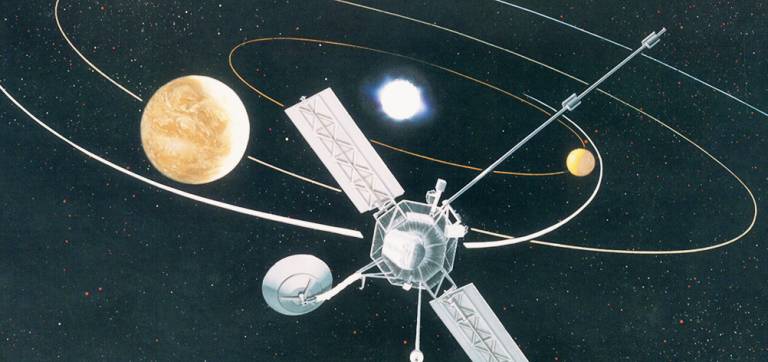UK astronomers reach deep into space and time
21 September 2015

A three-dimensional map of the Universe, reaching deeper in space and time than any yet made, is to be produced by an international team of 200 scientists, including leading astronomers from the UK.
The high resolution map will be produced using the Dark Energy Spectroscopic Instrument (DESI), an apparatus that will observe the light from more than 30 million distant galaxies.
A collaboration of UK physicists and astronomers, including groups at UCL and the Universities of Portsmouth and Durham, will be working on the instrument, which is designed to improve our understanding of the mysterious 'dark energy', and how it affects the expansion history of the Universe. It will also measure the velocities of hundreds of thousands of stars in the Milky Way galaxy and provide clues about the nature of the equally mysterious dark matter.
The Science and Technologies Facilities Council approved funding for UK scientists to play their role in this project last year, and the U.S. Department of Energy has just approved the project's scientific scope, schedule, and $56M funding profile. The new instrument will start taking data in 2019, and will run for 5 years, reporting its main results in the mid-2020s.
Professor Will Percival, from the University of Portsmouth's Institute of Cosmology and Gravitation, led the bid for the UK to take part in this project.
He said: "Since the discovery that the expansion of the Universe is accelerating, astrophysicists have been trying to understand the physical process driving the acceleration. They cannot do this using known physical laws and materials. "
"DESI will enable an awesome experiment: the results will be a factor of ten better than we have at the moment. They will revolutionise our understanding of the Universe."
DESI will be mounted on the four metre Mayall telescope at Kitt Peak National Observatory near Tucson, Arizona. The Mayall telescope's moving weight is 375 tonnes so it can easily support the weight of DESI, which is five tonnes. The telescope's top end will be replaced with DESI's optical corrector and focal-plane system, whose design is being coordinated in the UK as part of the UK contribution to the project.
Professor Peter Doel (UCL Physics & Astronomy) who is leading this work explained: "The corrector's six glass lenses, each approximately a metre across, will focus the light from the existing four metre diameter mirror onto the new focal plane. They have to be aligned to an accuracy of one hundredth of a hair's thickness, and this alignment must stay fixed as the telescope moves, to provide crystal clear images."
The focal plane, 80cm in diameter, will consist of 5,000 tiny robot arms, each holding an optical fibre. The closely packed robots position the fibre ends to capture the spectrum of a single galaxy. After a 15 to 20-minute exposure, the telescope aims at a new patch of sky; in less than a minute the robots rotate and reposition thousands of fibres.
The 40 metre long optical fibres cables then feed the light down to the spectrographs where the light is measured, and the Centre for Advanced Instrumentation at Durham University is leading the production of these cable runs.
Dr Jeremy Allington-Smith, Associate Director of the Institute for Advanced Instrumentation, said: "In Durham we have developed the expertise to produce extremely efficient fibre runs, which means that almost all of the precious light from these faint objects is usable at the end. It's great to put this expertise to such an important use."
The final three-dimensional map of galaxies will reveal how dark energy and gravity have competed over time to shape the structure of the Universe-both the regular clustering of galaxies and dark matter on the largest scales, and the idiosyncratic motion of individual galaxies. At the end of the survey we will know a lot more about the dark matter and dark energy that make up most of our Universe.
 Close
Close




